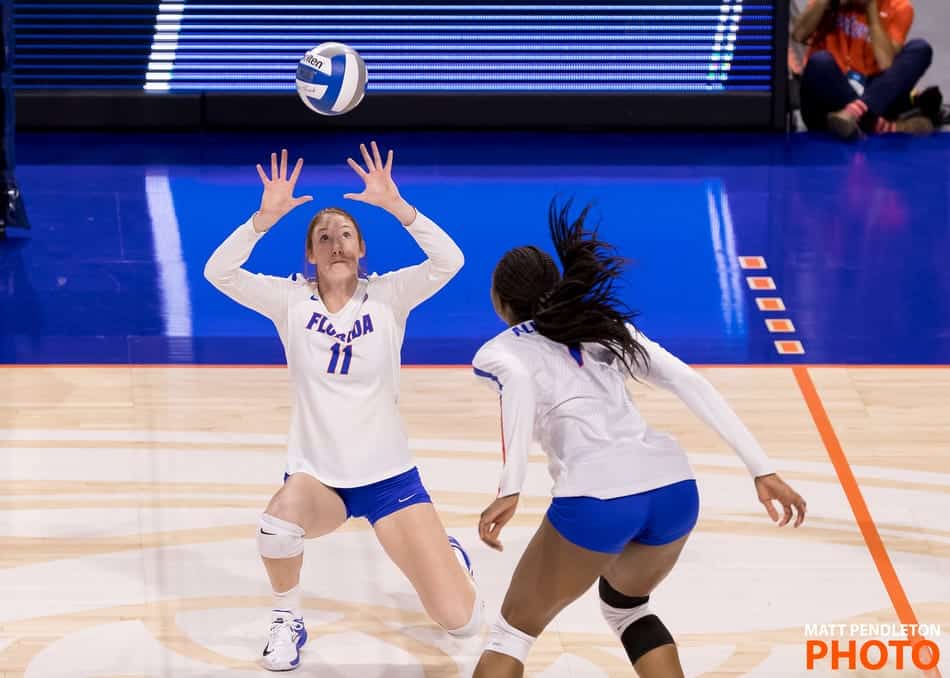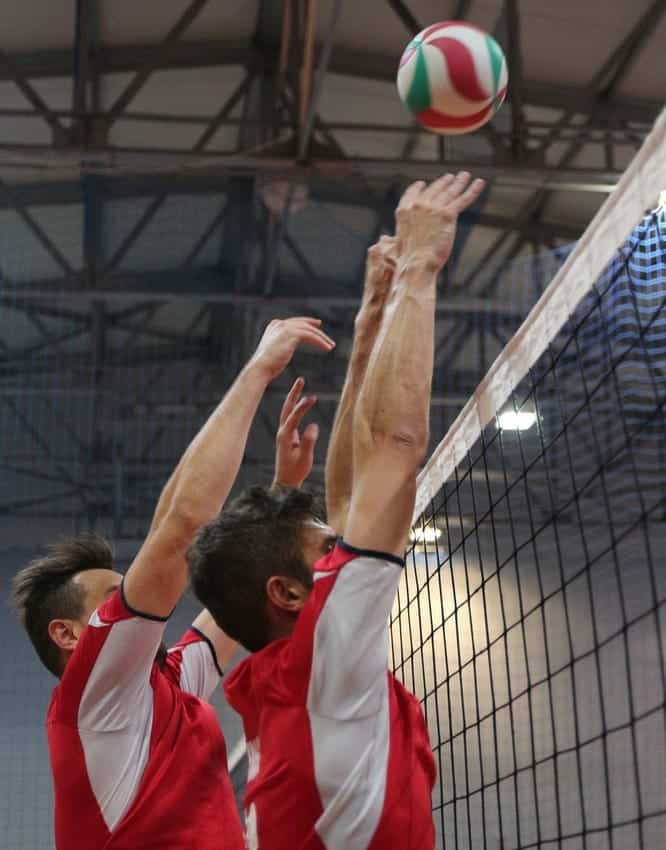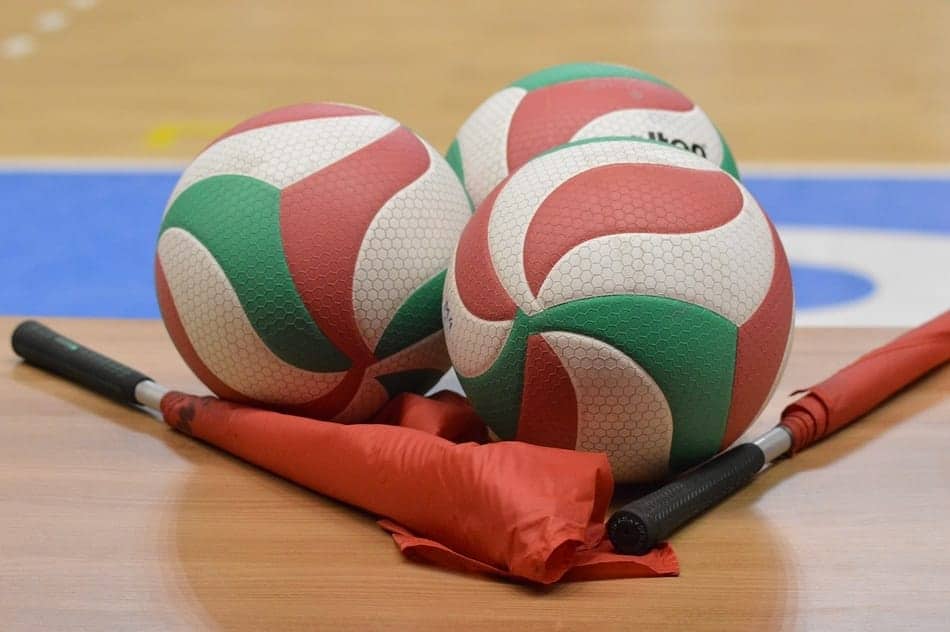Volleyball is an exciting and challenging sport. There are so many different skills to work on improving as you begin your volleyball journey. Young players, parents that are new to volleyball, and new coaches often ask themselves: “What are the main fundamental skills in volleyball?” and what should we work on mastering first?
The 6 Fundamental Skills Are:
In the image below, they’re arranged in order of importance and progression. There’s no sense in mastering your blocking skills when you haven’t learned to serve yet! As you progress there will of course be skills you use much more than others, but these are all fundamental skills you will learn as you grow as a player.

Whether you’re teaching volleyball in a physical education class, or you’re a player who is working on beginner volleyball fundamentals, this list will help. Follow the links below to go more in-depth on each of the topics and to find some helpful drills.
New coaches may find it helpful to work down this list with their team and spend some time on each area to evaluate their team’s ability.
Serving
As a new player, this is the first major hurdle you face, can you serve the ball? When it’s your turn, it can be pretty scary to step to the line with everyone watching you. You may feel a lot of pressure or even embarrassed.

Remember that every player who has ever played the sport of volleyball in the entire world has been in your shoes! Every player on the court with you has had to face that experience. They all know what it’s like and they’re still playing.
So be calm and patient and take your time to do your best. Remember, in volleyball, serving is the only time you are in complete control of the situation and you can take a moment to gather your thoughts and focus on using good technique.
Every other skill is going to be used in the motion of gameplay, but serving is done as slow as you need it to be.
If you would like help in mastering different types of serves, check out this article: Mastering The 4 Types Of Serves In Volleyball.
Passing
Passing is when you are making the first contact as the ball comes over the net. Whether you’re receiving the serve, playing a freeball, or defending an attack, you want to pass the ball to your teammate to help your team create an attack.
Often as beginners, we try to just bump the ball to the other side of the net and hope the other team messes up. At its roots, that’s how volleyball started. But the sooner you can learn a passing mentality, the better you’re going to do at volleyball.
As a coach of a young team, this is critical! In the early ages, this can be the most important and sometimes difficult lesson to learn.
I remember during my daughter’s first club season, her coach drew a line in the sand. Her team would get into the habit of playing back at the other team however the other team played. If they made 3 hits, we made 3 hits. If they just bumped the ball back over, we did the same.
Our coach knew that this had to stop! She told our girls they would be making 3 hits every time the ball came over, she didn’t care if we lost every point in the game, it would be with 3 hits. As parents, we held our breath.
Our team played another rally or two and then someone really messed up. On a freeball, she just bumped it right back over, not even trying to keep it on our side.
That was it! Our coach called a timeout and had our girls line up down the sideline facing their parents. Then she told them to drop and give her pushups until the ref blew the whistle.
As a dad who loves these kids, that was hard to watch. But you know what? That was exactly the kind of coaching they needed! In all of our volleyball experiences, that particular team was the most improved team I’ve ever seen in one season.
Passing is not just keeping the ball from hitting the ground, it’s choosing where you’re going to send the ball next. Before you make the contact, think about where your target is. Your setter is counting on you to give them a playable ball so they can set up an attack.
Most of the time your pass should be an underhand platform pass. This is where you keep your hands together with your arms straight out in front of you.
You use your forearms to create a flat surface that the ball will bounce off of. You are creating the right angle for the ball to go in the direction of your target.
Don’t swing your arms, the usually has enough speed to pass without much more energy added. Instead, you are trying to redirect that energy. Use your legs to add any extra power you need in your pass, by coming up out of your squatting stance as you make contact.
Setting
Setting is usually the second contact with the ball on your side of the net. The set is what decides whether your team will be sending back an attack, a freeball or maybe not sending it back at all.

If you’re fortunate enough to be chosen to be the setter, take it as a wonderful challenge. The setter is known as the quarterback of volleyball. Your role is sending your teammates the perfect ball that’s going to help them dominate!
Setters almost always use a volley which is the overhand finger pass. You are using flexible hands to redirect the ball to a target your hitter can spike.
In some cases, you may use a platform pass to bump set. This is legal and fine, but most players can’t do this as consistently, so we tend to volley.
As you are setting you need to have clear communication with your team, calling what you are setting and to whom. For this, you need to understand what your coach wants as a gameplan and be aware of where your teammates are on the court.
In general, you’ll be trying to set the ball high enough that your hitter has time to make an approach and try to kill it, so you’re setting the ball much higher than they can reach when they’re at the top of their swing.
You want to be setting them close enough to the net that they will have a great location to hit from, but not so close the other team has a chance to play it before your hitter can. Try to keep it between 1 to 2 arm lengths from the net.
For more setting tips, check out this article: How To Set A Volleyball: A Beginner’s Guide.
Hitting
Hitting or attacking is the 3rd contact your team makes with the ball when it comes to your side of the court. There are many kinds of attacks, but the fundamental skill of hitting comes down to the spike.
When you are attacking the ball, you have to be ready by being further away from the location you want to spike, so that you can make an approach. Your approach will be 3 steps and then a jump, so you need to be far enough back from the net to accommodate that.
As your setter begins setting you, you’ll step left-right-left and then jump with both feet (if you’re a right-handed hitter). During your last step, you’re reaching back with your arms to swoop them both up and create power and momentum with your jump.
As you jump, reach high and then you lead your target with your non-hitting hand, extending it out in front of you while you coil your hitting arm back. You hitting elbow should point directly behind you, while your hitting palm should face away from your head.

As you reach the apex of your jump you want to be connecting with the ball. You will spike the ball with the palm and heel of your hand.
You should “snap” your wrist as you connect with the ball. This means to strongly force your hand down in a whipping motion right at the second of follow-through. This gives the ball topspin and forces it to the floor instead of letting it sail out of bounds.
A really good hit is the most fun you can have in volleyball (okay, that’s 100% opinion, but seriously). It’s tough to get the mechanics right, but practicing that will be time well-spent.
Out of all the aspects that make volleyball fun, I enjoy competing at the net most of all. A lot of times it just comes down to who wants it more. There’s no feeling like going against a good blocker, or even two, and blasting the ball in just the right spot where they can’t stop you.
For more tips and drills to help you with your hitting, check out this article: 8 Fantastic Volleyball Hitting Drills And 2 Exercises.
Digging
Digging is a more advanced, fundamental skill in volleyball. Digging is receiving and saving the ball from an opponent’s hard-driven attack.
As you progress in volleyball the attacks become more and more refined. The ball comes quicker, it comes at harder angels, and hitters strike with more strategy.

As a defender, you need solid digging skills to keep your team in the game. Playing good defense has a lot to do with your observation skills while the ball is on the other side of the net.
It’s easy to see liberos and defensive specialists make some incredible digs and think that they’re lucky or that they just have lightning-quick reflexes. While reflexes have a part to play, this part of the game is far more mental than it appears.
For more on how to excel at digging, check out this article: What Is A Dig In Volleyball? Lessons, Drills, And Techniques.
Blocking
I believe blocking is the most advanced of the fundamental volleyballs skills because it really comes later in your volleyball development. Until you’re playing at a level that has consistent hitters, there’s not much use for blocking. That being said, a strong middle blocker can make a huge difference in some middle school teams.

Blocking really has 2 goals; denying your opponent’s attack and when that fails, limiting where that attack can go. Of course, you’d be happy to stuff block every hit your opponent tries to send your way. Many times, your block is going to restrict where they can send the ball and that helps your defense to be able to dig much more successfully.
While I shared above that hitting is my favorite part of volleyball, blocking comes a close second. It’s super satisfying to go up for a block and stuff the ball down on your opponent’s side of the net.
Good blocking takes more than just vertical leap. You need good footwork, good timing, and good hand technique to all work together.
For more help with your blocking, check out this article: Six Steps To Dominate In Volleyball With Incredible Blocking.
Related Questions
Volleyball Terms And Definitions
Are there things your coach has said that you don’t quite understand? Are the terms or abbreviations or acronyms that leave you feeling lost?
Check out my glossary for volleyball terms called: Volleyball Terms, Stats, Acronyms & Abbreviations.
What Is A Double Fault In Volleyball?
When a player on each team commits a fault simultaneously, the referee may call a double fault and the point will be replayed. For example, this could be when 2 players are competing for the ball at the net and both get entangled in the net at the same time.
What Do Line Judges Do In Volleyball?
Line judges are part of the officiating crew during a volleyball game. At high school levels and below in school volleyball, they will be volunteers. These may be parents or other students or other players not on the current playing team.

During club tournaments, a team will be assigned to “work” the game which includes 2 line judges. Their responsibilities include calling the ball in or out, calling a server for stepping over the line, and calling the touch if a player made contact before the ball went out of bounds.
For an in-depth look at how to call the lines, check out our article called Volleyball: Is It In Or Out?
Photo credits:
Feature image by Lcrward on flickr.com: https://creativecommons.org/licenses/by-nd/2.0/, cropped for size.
Serving image by Casey Stinnett on flickr.com: https://creativecommons.org/licenses/by/2.0/
Setting image by Matt Pendleton on flickr.com: https://creativecommons.org/licenses/by-nd/2.0/
Hitting image by David Baker on flickr.com: https://creativecommons.org/licenses/by-nd/2.0/
Digging image by AJ Guel on flickr.com: https://creativecommons.org/licenses/by-nd/2.0/
Blocking image by Marcin Skiba from Pixabay
Flags and balls image by Joanna_foto from Pixabay
Recent Posts
Athletes, listen up! Do you have a closet full of old jerseys, sweatpants, and tees that you just can't seem to part with? Well, dust them off, because you're sitting on a goldmine of fashion...
You may have heard, or you may have noticed, that there's been a change to the rule about double contact in volleyball. In 2022, an experimental rule change began to be implemented, where the double...
